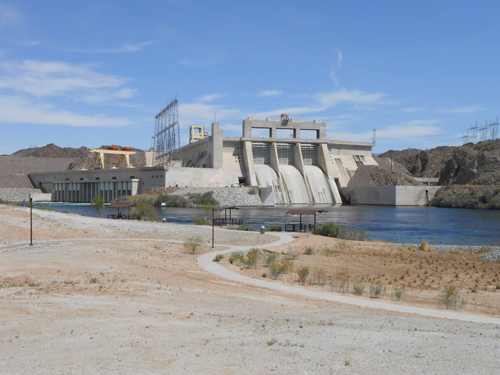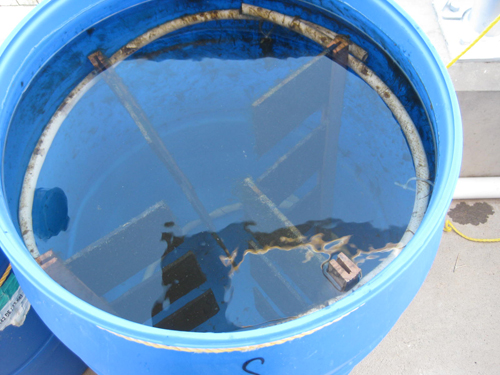Advanced Ultraviolet Disinfection Unit Provides First Cost-Effective Uses For UV Against Biofouling
Test Lab at Hydroelectric Power Station Showed Much Higher Extermination of Mussel Veligers Than Previously Available via UV, at Significantly Lower Energy and Footprint Requirements
Full-Size Medium-Pressure UV Treatment System Now Installed and Starting Up
By Dennis J. Bitter, director of industrial applications, Atlantium Technologies
A unique, medium-pressure ultraviolet (UV) disinfection unit, representing multiple scientific advancements for this treatment method, has provided 98+% reduction of veliger settlement in a pro-active dreissenid mussel control application, at UV doses lower than anticipated.
In addition, the unique unit has lower power consumption and smaller footprint than needed by most other medium-pressure units, while providing for a new level of treatment reliability.
Described as taking advantage of materially different science than previously available UV technology, by featuring fiber-optic and hydraulic principles applied to UV system design, the unit was originally created for effective control of pathogens in aquaculture applications. It was then further developed to gain EPA validation for adenovirus control, and FDA validation for pasteurization.
The expansion into effective biofouling control was first accomplished against barnacles and blue mussels at a power plant salt water heat exchanger intake in 2011-12, and then at a hydroelectric power station, via an on-site fresh water test lab, against quagga mussels in 2012. A full-size unit at the latter site has now been installed to protect a cooling circuit of one of the hydropower units.
Early industry attempts to deploy UV for mussel control, utilizing medium-pressure units, did not provide consistent reduction of veliger settlement, while taking up more space and utilizing more power. Thus, UV had not been regarded as proven and cost-effective against biofouling in industrial settings.
Demonstrated cost-effective applicability of the new, unique unit against macrofoulers in salt water now includes larvae of blue mussels, barnacles, oysters, and colonial hydroids. Assumed applicability to fresh water macrofoulers, in addition to quagga mussel veligers, includes larvae of zebra mussels, Asian clams, snails, colonial hydroids, bryozoans, and golden mussels.

In 2007, quagga mussels were discovered in the lower Colorado River, causing great concern for operators of hydroelectric plants there. With previous UV studies showing large footprints and high energy costs, while offering only mixed results, UV science was originally ruled out for the task of controlling the mussels.
UV Advancements Realized: Effectiveness, Reliability, Efficiency
The innovative unit has provided effective UV dose at medium pressure, reaching veligers passing anywhere along its inner steel wall, by taking advantage of a patented, quartz sleeve lining.
The quartz sleeve is surrounded by an air gap, which prevents the absorption of the UV radiation by the reactor wall, reflecting the energy back into the treatment chamber. This action mimicks a fiber optic effect that has been dubbed Hydro-Optic Disinfection™ (HOD).
The resultant unique disinfection chamber traps germicidal light waves and reflects them back into the water, thereby allowing for the significant scientific advancement of recycling the energy/dose throughout the entire chamber. Meanwhile, longer light paths provide for more inactivation opportunities per photon, while organisms are attacked from all directions.
As a result, the new unit provides a uniform dose, preventing previous problems with UV applications that derived from the average dose not being the real dose---i.e., it was working near the lamp, but not near the housing wall.
In addition, two sensors on each polychromatic medium pressure lamp enable automatic dose adjustment according to water conditions, such as UV transmissibility, in real time, thereby providing a significant advancement in reliability not previously available with UV. Patented associated instrumentation, logic, and controls modulate power in and out of the lamp, with the sole purpose of providing an effective UV dose.
The polychromatic lamp irradiates the entire germicidal spectrum required to damage the organisms. When the lamp gets older and its output decreases, more power is provided automatically to compensate.
With a built-in ultraviolet light transmission (UVT) sensor continuously monitoring water quality for UV transmittance, the control system also allows for maintenance of effective dose with changes in UVT, such as occurs when turbidity increases during a storm. In addition, it provides for changes in flow rates through the unit via an external flow meter that transmits water flow rate data.
In either case, power use is maintained into and out of the lamp to maintain the desired UV dose. Consequent lower energy consumption, and longer lasting lamps, provides for a significant scientific advancement in the level of efficiency in the use of UV energy.
The HOD UV technology is environmentally friendly by eliminating the need for chemicals while providing preventative control of macrofoulers in systems protected. And since it does not affect the water quality, it does not require a National Pollutant Discharge Elimination System (NPDES) permit.

A trial evaluation of the scientifically advanced UV unit was carried out independently in 2012 by RNT Consulting Inc. of Picton, Ontario near a lower Colorado River hydroelectric plant. Raw water containing quagga mussel veligers was drawn into a flow-through field laboratory at the rate of 7 cu.m./hr.
Proven Biofouling Applications
Fresh Water
In 2007, quagga mussels were discovered in the lower Colorado River, causing great concern for operators of hydroelectric plants there. As harmful chemicals could not be used against the macrofoulers, non-chemical alternatives were required. Among the technologies originally investigated were high-flow, low-micron, self-cleaning filters; bio-pesticides; and UV.
With previous UV studies showing requirements for large, capital-intensive systems with numerous lamps that called for high energy costs, while offering only mixed results, UV science was originally ruled out for the task.
However, a trial evaluation of the advanced HOD unit was carried out independently near a lower Colorado River hydroelectric plant in 2012 by RNT Consulting Inc. of Picton, Ontario.
Four separate experiments using different UV doses were conducted between May and September, using an on-site laboratory and the water source of interest.
Environmental conditions were the same as for the water circulating in the power station that cools all vital rotating machinery, via large and smaller pipes, at varying flowrates.
Raw water containing quagga mussel veligers was drawn into a flow-through field laboratory at the rate of 7 cu.m./hr.
“The system performed flawlessly throughout the four experiments, with veliger settlement past the UV lights decreased by 98% to 99% in all four,” said Renata Claudi, MSc, a co-principal with Thomas Prescott, PEng, at RNT Consulting Inc., in her comprehensive January, 2013 report on the trial, Evaluation of Atlantium UV Technology as Means of Eliminating Downstream Settlement of Dreissenid Mussel Veligers.
RNT Consulting was established in 1998, with primary area of interest the control and mitigation of biofouling, as well as addressing issues arising from aquatic invasive species, and now regarded as experts in North America in the control and mitigation of biofouling. Contract work has been performed for various clients, including Environment Canada, Transport Canada, U.S Army Corps of Engineers, Ontario Power Generation, Central Arizona Project, Salt River Project, Southern Nevada Water, California Department of Water, and Brazilian and Spanish utilities.
“These results of the trial evaluation on the lower Colorado River are particularly impressive, as the actual dose which was delivered by the equipment was much lower than the dose selected,” she continued. “The lower dose was the result of fouling of the quartz sleeve surrounding the UV bulb---a level of fouling that was much greater than originally anticipated. Automatic wipers would have kept the quartz sleeve clean.”
As a result of the independent trial evaluation, a full-size system for a plant cooling circuit has been installed, and is scheduled for startup during June, 2013. The full-size system includes wiper technology for optimal protection of the quartz sleeve.

The advanced UV system performed flawlessly throughout four experiments, with veliger settlement past the UV lights decreased by 98% to 99% in all four, as measured via settlement plates mounted in barrels.
Salt Water
The power plant demonstration was conducted between July, 2011 and May, 2012 at the Israel Electric Corporation’s Orot Rabin site in Hedera.
The HOD unit was installed ahead of a heat exchanger that had been prone to severe macrofouling from settlement of barnacle and mussel larvae present in the raw seawater intake. An identical but unprotected heat exchanger, in a parallel system, was used as a control. Both heat exchangers were cleaned manually just prior to the start of the demonstration.
After six months of continuous operation, both heat exchangers were inspected. The one used as the control had a high level of macrofouling, while the one protected by the HOD UV was almost pristine. The study concluded that UV treatment of entering raw water could minimize macrofouling, improve heat exchanger performance, and substantially increase the time between maintenance cycles.
HOD Unit Manufacturer
The Atlantium HOD™ MP-UV advanced UV system was developed by Atlantium Technologies Ltd., a privately owned company founded in 2003 “with the technology and the will to make a significant contribution to the environment by providing safe water disinfection solutions”.
Its largest shareholders are Aurum Ventures MKI and Elron Electronic Industries Ltd., with other major investors including Aster Capital and Aeris Capital.
For further information regarding biofouling and other industrial applications, contact Dennis J. Bitter, Atlantium Technologies Ltd., (941) 923-9990, mobile (714) 305-6111, dennisb@atlantium.com.
Dennis J. Bitter is director of industrial applications in North and South America for Atlantium Technologies’ HOD™ MP-UV advanced UV system
